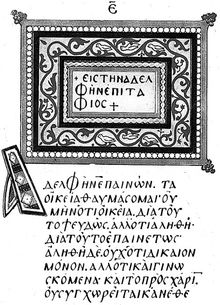The Day of Slavic Writing and Culture
On May 24, the entire Slavonic community pays homage to Saints Cyril and Methodius and celebrates the Day of Slavic Writing and Culture. It is celebrated with special solemnity in Bulgaria with festive marches of Cyrillic alphabet and iconic images of the Saint Brothers. In 1991, the day was proclaimed the official holiday in Russia and since then has been extensively celebrated in this country too.
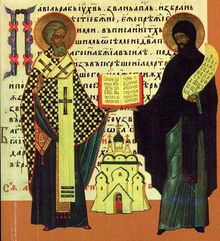
The value of writing for the human civilization development is beyond estimation. The language reflects the entire world and our lives as a mirror.
The opportunities the writing provides can neither be restricted by time nor by distance. However, there were times when people knew not how to write. This art has been developing for a long time through many thousands of years.
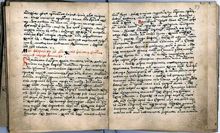 A collection of SS Cyril and Methodius’ hagiographies
A collection of SS Cyril and Methodius’ hagiographiesThus, the Greeks developed their own alphabet based on Phoenician writing and improved it introducing special signs defining the vowel sounds. The Greek writing laid the foundation for the Latin alphabet, and in the 9th century, the Slavic writing was first developed based on the Greek alphabet.
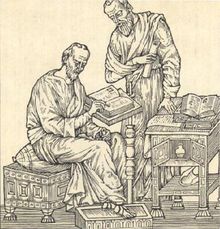 Cyril and Methodius, a miniature
Cyril and Methodius, a miniatureCyril and Methodius were born in the 9th century in Thessaloniki. In 862, both brothers were destined to enter upon the work, which gave them their historic importance. That year Prince Rostislav of Great Moravia requested that Emperor Michael III and Patriarch Photius sent missionaries to evangelize his Slavic subjects, to tell them of Christian books and their sacred meaning.
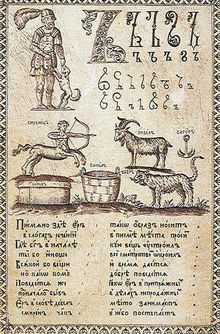 Karion Istomin. ABC book, Moscow, 1694. Archive: Hagiography of Saint Alexander Nevsky, part of the 16th century Illustrated Chronicle of Ivan the Terrible
Karion Istomin. ABC book, Moscow, 1694. Archive: Hagiography of Saint Alexander Nevsky, part of the 16th century Illustrated Chronicle of Ivan the TerribleKonstantin (Cyril after taking the monastic vows) and Methodius travelled to the Slavs to devise Slavic alphabet which later was called Cyrillic. The credit in this affair goes to Cyril primarily; as for Methodius, he was his right-hand man. The alphabet composed by Cyril was suited to match the specific features of the Slavic language.
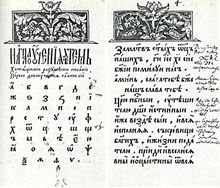
This is how the event is described in the Primary Chronicle, the main historic reference material of Old Russia:
“Once Slavic Princes Rostislav, Svyatopolk and Kocel sent the ambassadors to Emperor Michael to impart the following words, ‘Our land is baptized but we have no teacher to guide us and explain the sacred books. We know neither Latin nor Greek; we know neither letters, nor their meaning. Send us, therefore, the teachers who could reveal the book words and their meaning to us’.”
 Cyrillic Ornate Lettering
Cyrillic Ornate Lettering“Then Emperor Michael sent the two scholars, Brothers Cyril and Methodius, to the land of the Slavs ruled by Rostislav, Svyatopolk and Kocel. When the brothers arrived, they commenced to devise the Slavic alphabet and translated the Apostle (a church service book with excerpts from the Acts and Epistles) and the Four Gospels.
Origination of Slavic writing dates back to 863.
 Uncial Cyrillic Book Hand
Uncial Cyrillic Book HandHowever, there were some people who reproved the Slavic books and said, "No people must have their own alphabet except for Jews, Greeks, and Romans like in Pilate’s inscription on the Cross featuring but these three tongues”.
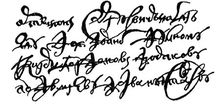 Cyrillic Cursive Handwriting
Cyrillic Cursive HandwritingTo protect the Slavic alphabet the brothers Konstantin and Methodius travelled to Rome. The Roman bishop condemned those who were murmuring against the Slavic books, "Let the Word of the Scripture come to life: 'Let all peoples praise the God!' which means that every people can pray to God in their native tongue.’" Thus he affirmed a church service in the tongue of the Slavs.
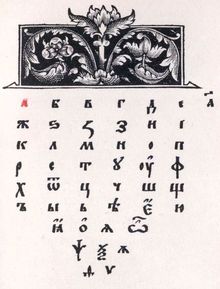 Ivan Fyodorov’s Azbouka (Alphabet) reflects an ancient alphabetic teaching method, inherited from the Greeks and Romans. The book contains an alphabet of forty-six letters, from “Az” to “Izhitsa”.
Ivan Fyodorov’s Azbouka (Alphabet) reflects an ancient alphabetic teaching method, inherited from the Greeks and Romans. The book contains an alphabet of forty-six letters, from “Az” to “Izhitsa”.The words read in Old Slavic are pronounced exactly as they are written. The discordance between the pronunciation of the words and their transcription is not characteristic for Old Slavic as it is for English and French. The Bookish Slavic (Old Slavic) language was widely spread as the common language among many Slavic nations. It was used by Southern Slavs (Bulgarians, Serbs, Croats), Western Slavs (Czechs, Slovaks) and Eastern Slavs (Ukrainians, Belarusians and Russians).
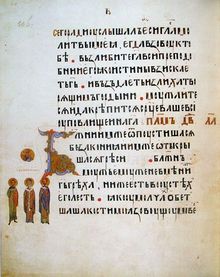 A page of the Glagolitic alphabet
A page of the Glagolitic alphabetOn May 23 within the framework of the celebrations dedicated to the Days of Slavic Writing and Culture on the threshold of the SS. Cyril and Methodius Day, the Contemporary Museum of Calligraphy will present a new exposition, entitled “The Slavic Writing. Origins, History and Development.”
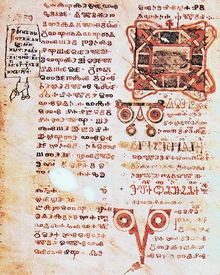
The visitors will be able to learn more about the history of Slavic Writing and various types of handwritten Cyrillic: Uncial, Half-Uncial, Cursive, and Ornate Lettering and participate in calligraphers` master-classes.
